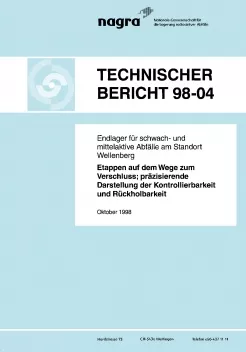
Technischer Bericht NTB 98-04
Endlager für schwach- und mittelaktive Abfälle am Standort WellenbergEtappen auf dem Wege zum Verschluss; präzisierende Darstellung der Kontrollierbarkeit und Rückholbarkeit
In 1994, GNW (Genossenschaft für nukleare Entsorgung Wellenberg -Co-operative for Nuclear Waste Disposal, Wellenberg) submitted an application to the Federal Government for a general license to construct a repository for low-and intermediatelevel nuclear waste (R-L/ILW) at the Wellenberg site in Wolfenschiessen, Canton Nidwalden. The general license specifies the site location and the basic characteristics of the project. The application required information concerning the construction and operation of the facility, describing the "approximate layout of the underground and surface structures". Correspondingly, GNW dealt only briefly in the application documentation with questions of the possibility of repository inspection and waste retrieval. In the application, the repository concept fulfils the legal requirements which give priority to long-term safety -the repository must be safe on the long term, even without surveillance. Surveillance and inspection are nevertheless planned, just as retrieval of the waste remains a theoretical possibility even after the repository has been closed. However, the long-term safety may neither depend upon these provisions nor be compromised by them. The point in time at which the repository should be closed was not specifically discussed -there was a tacit agreement that the repository caverns and access tunnels would be closed and sealed step-wise according to operational requirements.
The problems of inspection and retrieval were of great importance in the public debate, particularly in the run-up to the referendum in Nidwalden on the application for a general license and for the cantonal license in 1995. In 1996, bearing in mind the rejection of the license application and the positive conclusions of the safety authorities regarding the repository project, the Federal Government made the following comments concerning future activities: in meetings with all concerned parties, an attempt should be made to reach an agreed solution. During the course of these, a further referendum on a reworked project should not be discounted. In order to discuss amendments to the project, a technical working group was appointed which, at the request of the Nidwalden cantonal government, also addressed questions relating to the repository concept, i.e. retrieval, inspection and closure.
As a result of the discussion on inspection and retrieval, both in public and within the Wellenberg technical working group, GNW decided to specify the corresponding repository project stipulations more precisely and to adapt them to the results of the discussions. As demanded by the ethical and legal outline conditions, the priority of long-term safety was maintained in a passive manner, free from any human uncertainty factors. The procedure for closing the repository was changed and the time of closure defined. Before closure, there will be a phase in which the waste can be retrieved easily, facilitated by dispensing with the continuous backfilling of the caverns during emplacement of the waste. During this phase, the waste containers will be securely stacked in the caverns and easily accessible. Consequently, the decision on closure need not be made before future generations have convinced themselves of the safety and appropriateness of the solution provided. This planned procedure provides an ideal combination of legal requirements ((passive) long-term safety), ethical requirements (the benefiting generation handling the waste disposal problem themselves) and political requirements (providing as much leeway as possible for our descendants). The modified repository concept fulfils all of these requirements equally.
GNW has assigned to Nagra the task of investigating the consequences of this phase of easy retrieval for the constructional and operational design of the repository and any possible effects that this phase may have on operational and long-term safety. This report contains the results of that investigation. In the introduction, the definition of the repository inspection and retrieval possibilities during implementation of the different phases of the repository is summed up. From this discussion, it emerges that it is certain that waste will be retrievable even after the repository has been closed, although it will be more technically difficult.
A more detailed analysis of the modified repository concept shows that, with appropriate construction, stability throughout the planned time period of one hundred years can be guaranteed. The modified concept assumes storage of all waste in prefabricated containers. This safeguards the easy retrieval of the waste and allows the caverns to be backfilled without difficulty at a later date. Examination of radiological operational safety has shown that safety targets for both normal operation and for any possible disruption can be adhered to.
The introduction of a phase of easy retrieval results in no changes to the sealing barriers after closure. All the components in the original plan will be built-in or used. However, the phase of easy retrieval could have consequences for certain properties of selected repository components relevant to safety. In particular, the ventilation of the caverns which have been kept open will lead to partial carbonisation of the buffer material in the repository containers. The safety analysis has, however, shown that even with the introduction of a phase of easy retrieval, safety is guaranteed and that, even after the definition of a modified repository concept, the Wellenberg site can still provide a safe repository for low-and intermediate-level radioactive waste.
